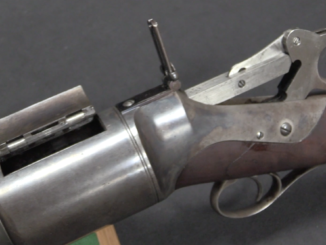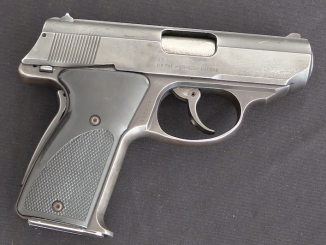In 2017, Hudson released a new pistol that was the darling of the firearms industry. It purported to offer a radically low bore axis and 1911-style trigger in a striker-fired system that would be fast and simple to use.
In 2019, Hudson went bankrupt, out of money and having started to scavenge parts off returned pistols to fix other customers’ broken guns. It was an ignominious end to a product with such potential.
About that same time, Daniel Defense was looking for a way to expand their catalog into the pistol market. They saw Hudson, and it looked like the perfect opportunity to pick up a good design that seemed to have been the victim of management and cash flow problems. So DD bought up the patents and other aspects of the H9 pistol…but when they got a close look at the gun they realized, belatedly, that the whole thing needed to be redesigned.
In the years since, Daniel Defense has been fixing the H9. The fire control system remains fundamentally the same, but with no interchangeable parts – and now actually drop-safe. The exotic forward-mounted unlocking cams on the barrel are gone now, and the accessory rail is moved up enough to allow reasonable use of lights and lasers. The frame is aluminum and shortened for better concealment. The recoil spring system is much stronger, and the slide stop redesigned to prevent the breakages that plagued the original Hudson. Every part of the magazine has been changed, to fit the same 15 rounds into a shorter body and prevent over insertion. The slide is now cut for optics, with four different adapter plates to fit all the common footprints.
Shooting the new H9 side by side with the original Hudson, I think Daniel Defense has kept all the qualities of the design while fixing a lot of the problems it had. The gun does indeed have a lot less muzzle rise than more conventional designs, and the trigger feels quite nice. This is not a Grand MAster’s IPSC gun and it is not a subcompact pocket gun. It is a jack of all trades piece that can be carried as well as any service pistol (better than most, thanks to its quite narrow construction) and can hold its own in a variety of competition venues as well.
Developmental Prototypes of the Original Hudson H9:




price?
According to their site https://danieldefense.com/daniel-h9.html it is $1,299.00
I said it on the Hudson video & I’ll say it this one: “Ian pre-reviews a future forgotten weapon.”
Let’s hope it doesn’t turn into DD’s Zip22…
Definitely a cautionary tale of the perils and the importance of the tiniest details in designing, developing and producing a gun, and for buying a design.
Many thanks to Ian for doing both this and the Rhodesian / Navy Arms Mamba vids.
Hopefully both the Hudsons and Daniel Defence recover from and grew from their experience.
I’m very much reminded of the contents of Jack Belk’s book, “unsafe by design”.
I think it’s still available free to download from Jack’s academia.edu page, as well as from amazon
https://www.amazon.com/unSafe-Design-Forensic-Firearms-Investigations/dp/0692343504
It’s been a rather long time since I read something by that Belk character, but I recall reading something .pdf-ish on the internet that struck me very much as being the sort of ambulance-chasing bullshit you’d expect from a professional “expert witness” working for the usual lot of litigious assholes that don’t want to accept responsibility for their own screw-ups.
Maybe I need to re-read it, and see if he’s become less bellicose and judgmental.
One of the problems I’ve had with a lot of this crap over the years is a.) the fact that an awful lot of the litigants in these cases are morons who violated almost every rule of firearms safety, and b.) that sometimes “Act of God” is a legit defense. I mean, yeah… Sure, sometimes a Remington Model 700 has failed, but when you see the state of some of them? It’s a wonder the damn things function. People simply do not care for firearms the way they should, and rarely if ever do any of the required maintenance on them. If one fails, how many times is it due to thirty years of WD-40 gummy bears in the lockwork?
More than I like thinking about. I thank God every damn day that Ballistol finally entered the US market for firearms cleaning and lubrication.
The state of the average firearm in the hands of the American public is a disgrace, and if you’ve ever been on a range when people are setting up for hunting season, or there’s been some sudden local crisis where everyone starts thinking about the state of their weapons…? Lord love a string of ducks, but it’s ugly. If I were a gunsmith, I’d have a truck set up as a workshop, and go down and set up outside the local ranges where people are doing their usual stupid thing. If you showed up with some basic solvent tanks and so forth…? Mint money, you would.
I swear to God on a stack of bibles, I once helped a guy out with a Winchester Model 94 that his grandfather had purchased back during the 1910s… Pre-WWI. That thing had never once, in its entire life of service during about every hunting season and several years of running fences on the family ranch, been cleaned and/or detail-stripped. The lever had to be worked with a rubber mallet when I first saw it, and it took me going down to the local tinsmith and having a dunk tank (like for bluing barrels…) fabbed up, and then soaking that poor thing for about a week. Kroil in the gallon jug is your friend in a case like that, and when I got done, the look of amazement on that guy’s face was something else. He’d had no idea that a Model 94 wasn’t supposed to be beaten open and closed…
I feel your pain. I could tell you tales of S&W M10s and Colt OPs that spent twenty years in Deputy Dawg’s holster and received nothing but some WD-40 or 3-in-1 oil spritzed inside once a year all through it.
I used to use George Nonte’s trick; take the grips off, drop it in a pot of boiling water, and wait. After about five to ten minutes, the amount of crud that floated to the surface was unbelievable. Yes, I dunked the vic in a nice pot of penetrating oil after the bath to drive off the moisture, then let it air dry in front of a furnace register.
A few times I ran into ones that were literally locked solid. Sometimes the only thing movable was the cylinder latch release and ejector rod. Those needed to be detail-stripped, and every time the innards were full of a spongy, grimy mass of dirt, dust bunnies, actual seeds, and Ghu only knows what else. I could often literally pull the stuff out and have a perfect negative mould of the action. I’m sure there would have been mouse nests if there had been room for the mice.
Once detail-stripped, cleaned by hand, rust removed (and there was always rust), properly lubricated, and reassembled, I never had one that didn’t work, even ones the “owners” swore were so “busted” they were only good for fishing sinkers.
Myself, my policy was always to strip, clean, and properly lubricate every firearm in my inventory twice a year, whether it needed it or not. Of course, as with model building, I actually find that sort of thing relaxing.
clear ether
eon
imo the book is well worth the time it takes to read it.
Remington in particular did know that they had problems with their products, in particular with the Walker trigger and the safety on the 700 and its variants.
Remington’s policy kept that necessary information from gun owners, by means of non disclosure agreements attached to settlements.
There were / are also problems with the “common fire control” and with the Nylon66
interestingly the 788 is actually a good design.
I fully agree that many guns are horrendously maintained, and that WD40 and its gummy residues are bad news for almost everything they touch
but that is not Belk’s point
he’s looking at actual design flaws, such as the floating connector piece inside the Walker Trigger, that cannot be directly controlled, short of epoxying and screwing it to the trigger or replacing the trigger unit with an after market unit.
I definitely recommend reading it.
Hungary made an Aluminum frame Walther PP/PPK clone that was, for the time, super lightweight and very cheap. This pistol had a limited life span due to the slide hammering the soft aluminum frame. Yet, it was used for the army, and no soldier would put 2000rounds through it. Up to this day it is popular with hunters and civilians who don’t plan to conduct regular handgun shooting.
But an expensive handgun like the Hudson is very likely purchased by handgun afficionados, who easily run through thousands of shots.
https://danieldefense.com/h9 claims that
…this new version of the Daniel Defense H9 was forged in the crucible of more than 1,000,000 test rounds. Not because it was required. But because we owe it to you that every firearm stamped with our name advances the legacy of battle-hardened reliability…
So it seems they tested it for high-usage scenario.
Or maybe they had to keep testing it over and over again because it took so long for them to get it right. to get it right. Could striving for excellence or marketing hype to cover up the problems.
Well that idea is certainly not suitable for boeing passenger jets “We’ll get it right! Next time, like a hoover etc.” what can go wrong?
I remember looking at the Hudson, originally. And after “Looking” at it, a fair bit… I thought; the point is the recoil spring being lower, egonomics dictate as low as the bottom of the trigger guard – Given said theory must dictate really it should be as low as the bottom of the mag, but that is egonomical/etc more difficult… But I figured that was the point in regards reducing muzzle climb. Sooo… What is the perhaps (Perfect) iteration of this idea “To reduce muzzle climb thus, if that is the idea & surely it must be, in my opinion.” Well probably… It is a hinged pistol grip. Yes. So what happens is, when you fire the muzzle moves forward. Quite. Given the idea, must be your wrist with a lower recoil spring should tilt down… More – Thus limiting climb. On that premise, if egonomically etc we can’t align the recoil spring with the bottom of the mag “That may even be to low” but any further up is not great ergonomically I.e. Star trek spok hand grip. What is to be done. Which brings me to the hinge.
Indeed… But what is the hinge.
The hinge, is… The pistol grip you are holding, allows the gun “Via this theory to recoil, forward – In away, and thus give the muzzle lowering of perhaps the impractical spok grip.” sooo… The pistol grip/mag must tilt, hinge.
Basically you’d want… The gun, to push towards the bottom of the mag approx… Have to draw on the back of a fag packet, I can currently see what I mean; but it may/will have “Issues” hmmm.
Sort of “backwards” (Jatimatic’ish) probably going to need a few drawings, so I will stop commenting untill I come up with something. But I think I am right overall, and thus it is a matter of how! As oppose, why.